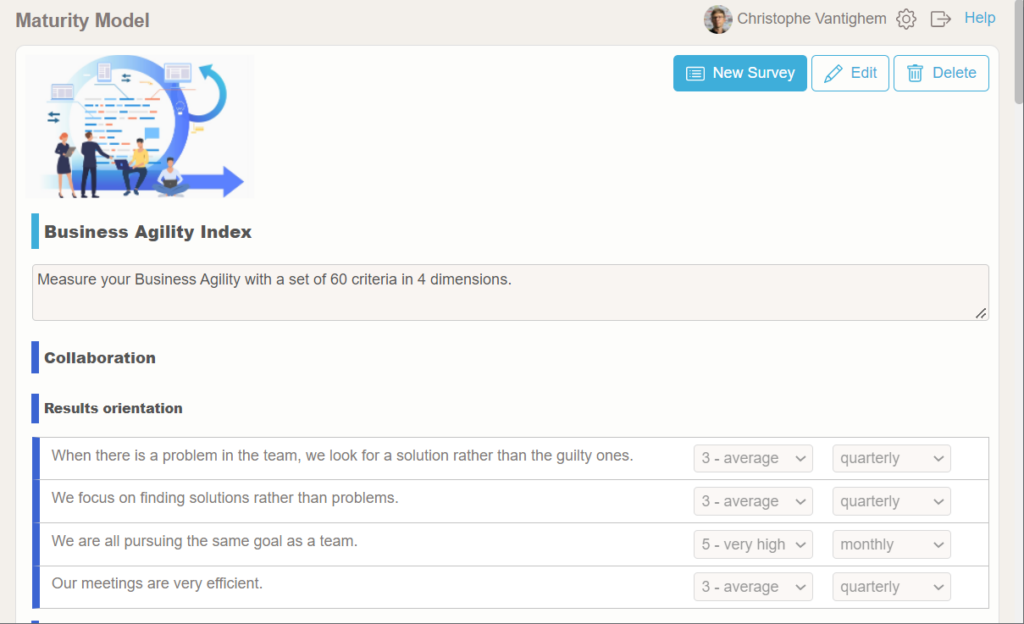In this post you will learn how to measure Business Agility effectively in your organization to accelerate the improvement of your organization toward agile excellence.
Business Agility is the ability of an organization to deal successfully with volatility, complexity and uncertainty.
Organizations having a culture of Business Agility respond quickly to change and learn faster in a productive and cost-effective way. As a consequence, agile organizations continuously build a competitive advantage on their market.
An agile culture is based on the values and principles of the Agile Manifesto which were laid down in 2001. Originally applied to Software Development, the agile values and principles are applied in every business which is dealing with complexity and volatility.
Measuring the Business Agility
The Sociologist George Caspar Homans has defined in his book The Human Group (1951) a method for measuring the maturity of groups.

In Homans’ model, each group acts in its own organizational and economic context. The group will begin to establish behaviors and norms that will enable it to adapt to this context. The team has reached maturity when all required behaviors and standards are applied. The team then becomes productive and reaches satisfaction.
Similarly to the measure of maturity, it is possible to measure Business Agility by identifying the required norms and behaviors, and assess their development in the organization. As in a volatile environment, the context of an organization evolves permanently, reaching Business Agility requires a permanent effort in the organization. That is the reason why we prefer to use the concept of “evolution model” over “maturity model”.
Using the Business Agility Index
At AgileValue, we have defined an Agile Health Check based on 4 dimensions:
- Collaboration: Are the team able to collaborate effectively and to resolve conflicts?
- Self-Organization: Have the teams sufficient autonomy to make the right decisions?
- Value Generation: Are the teams working closely with the customers to generate business value?
- Adaptability: Is the organization able to respond quickly to change and learn?
For each dimension, we have defined criteria which are either:
– A behavior. For instance, “we do what we have promised”
– A state. For instance, “we have clear goals”
– An experience. For instance, “I enjoy working in this team”
Following the principle of system thinking, the optimization of Business Agility has to be done on the whole organization and not only locally in a few teams. Therefore, it is important not only to assess the collaboration inside the teams but also the collaboration between the teams.
Adapting the Business Agility assessment
There is no blueprint for Business Agility that fits everywhere. Each organization has to find what Business Agility means in its context. In a highly regulated environment, some agile practices would be contra-productive. For instance, an organization cannot do experiments when people’s lives are in the game. So each organization has to choose what are the agile practices which are relevant in its context.
In our tool Teammeter, you have the possibility to build your own assessment model. For each criteria, you can define how important it is in your context and how often it has to be evaluated.

Assessing the Business Agility criteria
One way to assess the criteria is to do some interviews and observations in the teams. By participating in the team meetings you can see most of the behaviors and norms which are applied by the team.
Our preferred way is to request the teams to do self-assessments because the teams feel more involved in the improvement process and can better align to the common development goals.
In Teammeter, it is possible to generate a survey from your assessment model and invite your teams to participate in it. It requires only a few minutes to answer the survey, and the outcome is generally more precise than assessment from an external observer. The teams can leave some comments on the criteria, and it is a great starting point for discussing the future solutions.

The criteria are positive statements that describe the needed norms, behavior or experiences. They are assessed using a 5 points Linkert scale, which is used in psychology to rate attitudes, opinions and behaviors.
Aggregating the results
Each assessed criteria belongs to one or several topics from the assessment model.
On the radars on the Teammeter dashboard, you get an overview of the improvement areas for your team and your organization. You can select a topic from the radar and see the associated criteria.


The Business Agility index is calculated as the average of all criteria evaluations. The Business Agility index at the top of your organization is calculated with an average on all teams.
The value represents how close the organization is from the development target. This goal is moving as your organization will discover continuously new professional practices. So consider the evolution of this metric rather than the absolute value.
Conclusion
By measuring your Business Agility, you can identify improvement topics in your organization and decide actions to support the teams to progress in these areas.
To stimulate the improvement in your teams, you can let them use the retrospective tool from Teammeter where they can prioritize the topics in their context and decide actions.
The measurement of Business Agility is a powerful tool to measure the learnings of your organization. Like for other metrics, don’t use it to assess the performance of managers and coaches. The risk is indeed that people will focus on the optimization of the assessments rather than on the agile practices.
The Business Agility is a good indicator that your organization is able to manage complexity and volatility in an effective way. However, it does not indicate whether your organization is actually delivering value to your customers. Therefore, measuring the Business Value as well as the customer satisfaction remains a must to assess that your organization is making significant progress on the way to agile excellence.

